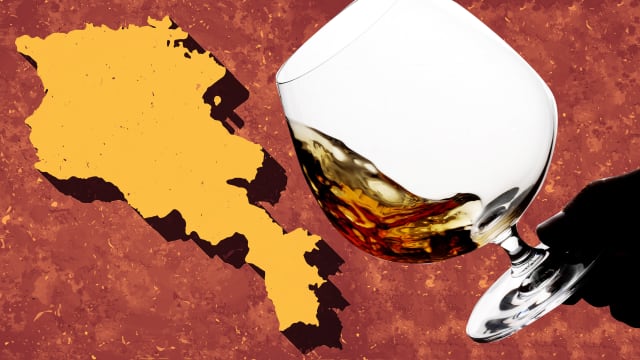Stalin and the Soviet Union brought Armenian brandy to the masses—and with it, a complicated legacy that’s been hard to shake ever since.
By Benjamin Kemper
(Daily Beast)- When you take the number 201 bus into Yerevan from Zvartnots International Airport, the first sign that you’re nearing the city is a hilltop citadel looming on the horizon with soaring arches, wrap-around stone walls, and landscaped lawns that slope gently down to the banks of the Hrazdan River—Armenia’s House of Parliament, you might think, or the prime minister’s residence. But this grand, iconic building welcoming visitors from near and far is, in fact, a brandy factory.
To most Westerners, Cognac and brandy conjure up images of French châteaux and European aristocrats but ask anyone raised in the Soviet Union what country springs to mind when it comes to great brandy, and the answer is likely to be Armenia. Even today, for many Eastern Europeans and vast swaths of Central Asia, Armenian brandy remains the gold standard. So why do most Americans know so little about it?
Armenia is legendary for its open-armed hospitality to foreigners—a local proverb states that every guest is a gift from god. So as a travel writer on the Caucasus beat, whenever I dined with Armenians, the bottle of kanyak (“Cognac” to locals) almost always came out at the end of the meal. Confession time: Until last summer, I turned my nose up at the stuff. You see, travelling around ex-Eastern Bloc countries, you learn quickly that European-Esque commodities, from waxy Russian chocolate to ersatz Georgian “Champagne,” are seldom any good. One hundred-proof booze made in a Soviet-era factory? That sounded downright hazardous—a surefire night-ruiner if not a Molotov cocktail to the innards.
But Ararat’s 10-year put me in my place. After a soul-satisfying meal at Sherep restaurant in Yerevan of roasted Lake Sevan trout, sharp local cheeses, and salads made from umpteen unrecognizable herbs, the waiter presented the check with a glass of caramel-colored spirit. Oh no, I thought, scanning the room for dry houseplants. I reluctantly took a sip. First came the vanilla notes, then hints of ripe tropical fruit followed by prunes and figs. Based on its complexity, I thought it must be French or Spanish. The waiter caught me blankly staring at my glass and sauntered over. “What is this?” I asked him. “Real Armenian kanyak,” he cooed, “made from our native Armenian grapes. Best in the world.” I found myself nodding in hypnotic agreement. Wobbling back out into the thick summer air, I suddenly had a mission: to learn what made Armenian brandy so distinctive—and why on earth such a stellar product wasn’t more widely known.
That’s how I found myself with a snifter between my fingers the next morning at the Yerevan Brandy Company (YBC), that hulking, fortress-like building at the edge of town, where Ararat 10 and all Ararat brandies are produced. I sipped while Zaruhi Saribekyan, the communications director, took me around. Our first stop was a hanging map of Armenia, which served as a helpful geography refresher: Armenia is situated between Georgia, Turkey, Azerbaijan, and Iran; at about 30,000 square miles, it’s roughly the size of Maryland.
Like French Cognac, Saribekyan explained, Armenian brandy starts with grapes—mostly endemic varieties with striking names like garan dmak, kangun voskehat (literally “golden berry”). “Our grapes grow in these regions,” she said, pointing to Ararat and Armavir on the Turkish border. After pressing them, she continued, the fresh grape juice ferments into a dry white wine, which is in turn distilled in French-style stills just like those you’d see on a Cognac factory tour in Charentes. The clear, high-octane liquid that dribbles out, eau de vie, is poured into Caucasian oak (Quercus macranthera) casks, where it mellows and matures for up to a decade, taking on a pleasing caramel color and woodsy depth in the process. Each brandy is then concocted according to blenders’ rigorous specifications, ensuring consistency year after year.
Now that I understood the “what,” I wondered about the “why.” With a bounty of other, long-established alcoholic traditions already existing in the region (wine, beer, and vodka, to name a few), why did Armenia choose to home in on kanyak?
To answer that question, we have to start at the end of the 19th century. At the time Armenia was ruled by the Russian Empire, whose aristocracy had been fawning over French Cognac ever since Hennessy hit the Russian market in 1825. Packaged in ornate glass bottles, Cognac was an instant status symbol.
Armenia got its first brandy factory in 1877 by way of an entrepreneurial Armenian businessman named Nerses Tairan and his Russian cousin Vasily Tairov, who had studied winemaking and distillation in France. But it wasn’t until Russian liquor biz bigwig Nikolay Shustov bought YBC 21 years later that Armenian brandy truly took off.
“It’s easier to climb up Mount Ararat than to climb out of the Ararat cellars.“— Maxim Gorky
Shustov had cornered nearly half of the Russian booze market by the time he arrived at YBC and saw great potential in Armenia as a brandy-producing powerhouse, not only for the region but for the world: It had sprawling oak forests, abundant spring water, sunny weather ideal for ripening grapes, and winemaking know-how gleaned from several millennia of viticulture (a 2007 archaeological dig revealed that Armenia might be the birthplace of wine). He founded Shustov and Sons on the site where YBC operates today, and by 1912, Shustov brandy was so prized that it was designated as official supplier of the court of Tsar Nicolas II. The Russian writer Maxim Gorky famously wrote, “It’s easier to climb up Mount Ararat than to climb out of the Ararat [brandy] cellars.”
In 1900, Shustov’s kanyak bagged the gold medal in a blind tasting at Paris’s International Exhibition, shocking the judges by beating out all of the prestigious French Cognac houses. The French were so taken by this new, exotic Armenian brandy, in fact, that the government granted Shustov permission to use the formal designation “Cognac” on his labels—a short-lived indulgence that was struck down by decree in 1909.
Shustov also came up with a shrewd marketing scheme that was remarkably ahead of its time. Allegedly, he would dispatch cohorts of well-heeled Armenians to the Continent, where they’d dine in fine restaurants and insist that they be served Ararat brandy. This, of course, was seldom behind the bar, so restaurant owners would rush to order it. Shustov effectively understood the principle of artificial demand before the term was even coined.
Back on tour, Saribekyan led me down “Presidential Alley” (their term, not mine, for the record!), a hall hung with photos of over 30 presidents who had visited over the years, toward a massive metal door protected by a uniformed guard. “Now I will show you our paradise,” she said, beaming. The door opened and we entered a cathedral-like room filled with cabinet upon cabinet of rare brandy bottles—a century of history in liquid form. The air smelled musty and oaky and sweet. This was a spirits geek’s paradise.
My eyes drifted to a row of bottles with yellowing labels. On them, I could make out “Dvin” in faded cyrillic lettering. “Dvin is the brandy Stalin supposedly gave to Churchill at the Yalta Conference in 1945, when Truman, Churchill, and Stalin met to mark the boundaries of postwar Europe,” Saribekyan said. I’d heard this yarn before—some versions even posit that Churchill had Stalin send him regular shipments of Armenian brandy into his old age—but I haven’t been able to verify it. The most reliable English-language book on Armenian food history, Armenian Food: Fact, Fiction & Folklore, by Irina Petrosian and David Underwood, traces the “Churchill-craze for Armenian Cognac” to an episode of the Soviet TV show Thirteen Moments of Spring, in which a character states that Churchill loved Armenian Cognac. “Since the program was extremely popular,” Petrosian and Underwood write, “that phrase was instantly accepted as a fact that didn’t need any supporting evidence.” Biographies of Churchill don’t mention Armenian brandy either.
Saribekyan’s rebuttal? “Of course there’s no document that proves Churchill drank Dvin at the conference—what was eaten and drunk at official dinners was not protocolled or recorded at that time,” she said, adding that an Armenian intelligence officer who was present vouched that the Armenian brandy was indeed served to the British Bulldog.
“In the 1930s, the regime decided that it was befitting of the ‘new Soviet man’ to enjoy luxury products previously reserved for the stars.“ — Lisa Granik, wine master
Regardless of what was poured at Yalta, Stalin, through his administration’s revolutionary reforms, was far and away the most influential force in the commercialization of Armenian brandy in the 20th century. At least that’s the opinion of master of wine and author of The Wines of Georgia, Lisa Granik. “In the 1930s, the regime decided that it was befitting of the ‘new Soviet man’ to enjoy luxury products previously reserved for the tsars, like Champagne, watches, perfume, chocolate, caviar—and, of course, Cognac,” she said. Producing and promoting such commodities on a mass scale aligned with the Soviets’ mission to sophisticate—and placate—a largely rural, illiterate citizenry that, by the time Stalin came to power, had been ravaged by years of poverty, war, and famine.
Armenia, like other Soviet nations, was eager to industrialize and modernize, but beyond that, it wanted to cement itself as culturally Western. Following the genocide of the Armenian people at the hands of Ottoman Turks between 1914 and 1923, Armenians were understandably keen to purge any remnants of their Islamic-influenced past (Eastern Armenia was under Persian rule for more than 300 years). Kanyak, viewed as the epitome of European refinement, was a way to prove their European-ness, hence why its production was so widely embraced as part of Armenian culture.
Just as Stalin chose his native Georgia to be the hub of Soviet winemaking, so his regime selected Armenia as a center of brandy production. After all, Yerevan had a number of factories already in operation, and Armenian brandy’s reputation had been established. By the 1980s, a quarter of the brandy produced in the Soviet Union came from Armenia, a staggering figure considering that the republic constituted a mere .001 percent of the USSR’s landmass.
The Soviet middle and upper classes were quick to bring Armenian brandy into their parlors, but at more than twice the price of vodka, the spirit was never an everyman’s drink. As in Europe, brandy was perceived as a special-occasion digestif, the type of tipple you’d serve guests you wanted to impress. It never went out of fashion, and the industry prospered—the palatial building I was standing in, constructed in 1953, stood as an emblem of that golden age.
But when the Soviet Union collapsed in 1991, so did brandy production. Across the region, people could hardly afford bread, let alone digestifs. And because of longstanding trade embargoes with Western Europe and the U.S., there was no international market for Armenian brandy to keep the industry afloat. That lack of demand, paired with a tanking economy and a bloody protracted war in the Nagorno-Karabakh region, brought even the best Armenian brandy houses, YBC included, to their knees.
Salvation for YBC—which remains the leading producer of Armenian brandy today—would come with controversy. In 1994 the French liquor corporation Pernod-Ricard acquired the ailing brand for $30 million ($52 million in today’s money). This infuriated Armenians. Ararat brandy was a hallmark of national identity and pride. How could such a symbol of Armenian culture be blithely auctioned off to a foreign drinks giant?
But the deed was done, and nowadays most Armenians have come around to Pernod-Ricard. Ararat Brandy is as refined and prestigious today as it always has been—improved, even, according to some critics.
“Following the break from the Soviet Union, Armenian brandy companies continued to sell to Russia and former Soviet countries because they were the lowest-hanging fruit,” said Granik. “People there already knew Armenian brandy and perceived it as great.” Indeed, if you step into any upscale restaurant from Kyiv to St. Petersburg to Tashkent, you can all but bank on Armenian brandy being on the drinks list.
European and American markets, however, remain elusive. “Remember, until recently, most Americans weren’t too keen on brown spirits anyway,” Granik said. “From the late 90s well through 2010, it was all about clear spirits—tequila, vodka, and the like.” But given the current craze for añejo tequilas, single-malt whiskies, and boutique rums, plus a newfound interest in the cuisines of the Caucasus (amber wine! khachapuri!), Armenian brandy seems ready for its break-out moment.
Saribekyan and I were now leaving “paradise,” and the tour was wrapping up. Our final stop was a smelling station where gleaming metal domes are lifted to classic brandy aromatics in their raw form, including chocolate, oak chips, and dried apricots. A bowl of vanilla beans, intoxicatingly sweet, transported me back to the glass of Ararat 10 that I’d savored the night before. I took advantage of the quiet to ask Saribekyan whether she was optimistic about Armenian brandy’s future, whether she thought it was on its way to being trendy. “Trends are complicated in this industry because a historical company like ours has brandies ranging from three to 50 years old, each with its own target customer,” she said. “But our market research shows that in the last five years, many more young adults are drinking our brandies, both in Armenia and abroad.” YBC currently exports to 41 countries including the U.S.
An unlikely cheerleader for Armenian brandy is Serena Williams, who in March took to Instagram stories to gush about Shakmat, the Armenian brandy company founded in 2018 that her husband, Reddit co-founder Alexis Ohanian, helped create. For his part, Ohanian is “looking forward to a few much-too-long-Armenian-style toasts of brandy with close friends once this [quarantine] is over,” according to an Instagram post from April 8. Perhaps a younger, more agile brand like Shakmat will finally put Armenian brandy on American bar shelves and pave the way for more traditional brandy houses such as YBC, Noi, Kilikia, Proshyan, and others.
In classic Armenian fashion, Saribekyan didn’t just say goodbye; she offered an open-ended invitation to return. The endless steps down to the bustling city gave me a moment to think about how dramatically Armenia had changed in the last century—evolving from a Soviet republic to a war-torn fledgling state to an unstable oligarchy to (thanks to the Velvet Revolution in 2018) a swiftly modernizing, Western-facing democracy. Through it all, brandy production never ceased. That is something worth raising a glass to.





